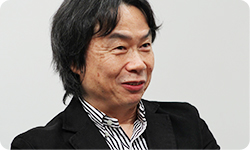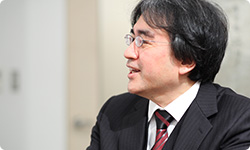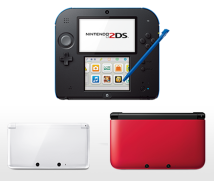5. It Grabbed Everyone´s Attention
Okay, our conversation has finally reached Nintendo 3DS.
Yes. (laughs)
Just like Miyamoto-san said, for a while after Nintendo DS and Wii came out, we didn’t attempt much with 3D aside from the Shigureden exhibit. As we approached development of our next handheld gaming device and considered the possible technologies, one of the developers said, “What about trying 3D?”
About when was that?
Um, about two years ago.
Yes.
Fairly recently then. That was about the time that everyone was embracing Wii.
Right.
Just when 3D had slipped our minds, a staff member said, “You know, 3D is a possibility.”
Was that someone not traumatised by past experiences with 3D?
Yes. (laughs) Someone unacquainted with the pain if I am to follow your phrase.
Yes. (laughs)
I had a hunch. (laughs)
After all, we had undergone some painful experiences in our efforts at 3D, so we’d grown somewhat reluctant.
I would think so. And you’d just had two big hits with Nintendo DS and Wii, so you might have preferred to stay well clear.
But the timing was not bad at all when we thought about it. The basic elements of Nintendo 3DS build upon those of Nintendo DS, so simply updating to the newest technology would naturally improve upon the graphics. The resolution would go up and the depictive capabilities would go up. In other words, we could create lots of images and display them. But if we just made a product with evolved graphics for creating pretty pictures, the product would end up being a device anyone can create.

Ah, I see...
So if we could create lots of images, I thought it would be good to create some for the right eye and some for the left eye. And because the resolution of the liquid crystal was improving, it would be easier to deliver those images to the right and left eyes separately. I thought that would fit into the project extremely well.
The physical evolution of the hardware, which allowed you to create lots of images, spurred the idea in you.
That’s right. We knew from our past experiences of giving up on 3D that graphics resolution is an important point when it comes to presenting 3D graphics well.
I see. After all, you had given up on 3D for the Game Boy Advance SP system because of that.
We were painfully aware that we would have to create two images, one for the left eye and one for the right eye.
And you strongly felt that you couldn’t do 3D with goggles. (laughs)
That’s absolutely true. Suppose ten percent of the total number of users bought goggles as an optional accessory. Then you’d be making 3D games for only that ten percent of users.
I see.
I think knowing these requisites beforehand was one of the backgrounds for us to be able to rather quickly determine that it might be the right timing.
And when it comes to handhelds, we get to provide each player with the screen. We can’t do that for home consoles, so handhelds are much better for presenting the world with 3D graphics.
Players get the screen when they buy the device, so you can deliver them high quality 3D.

One other good condition was that - since the Nintendo DS models have two screens - we could use the screen without 3D capability as a Touch Screen.
Oh, right.
Miyamoto-san spoke very clearly about that timing. He was quite passionate in claiming “We have to do it now!” He was very persuasive.
Oh, uh-huh.
At the exact time that Nintendo was going to bring out a new handheld gaming device, the quality of images rendered in real time by game consoles had gone up, liquid crystal resolution had increased, and the ability to deliver separate images to the left and right eyes had all improved, so there was no question that the time had come.
I see. It wouldn’t have been possible if all that hadn’t aligned with Nintendo’s timing for bringing out a handheld.
Right. And we could propose it precisely because it was a handheld. If all this had arisen when we were working on a home console, it probably would have ended up as an option.
In other words, if you had added it to a home console, it would have just become another “fun toy.”
Right. No matter how you looked at it, the timing was right and it all came together perfectly. I thought it was time to make our move, unless we would encounter some huge technological difficulties.
I see. When did you feel certain that the time had come, Iwata-san?
To be honest, I wasn’t able to have the strong assurance from the beginning, and many others concerned in the project shared mv view. We had run up against certain limits with past 3D products, and I had a variety of worries, from rather vague concerns such as whether 3D could really succeed, to concrete thoughts such as the idea that while players might be surprised at first, they might soon get tired of it. And I think there were lots of others along with me who weren’t so sure.
Uh-huh.
First we decided to see how 3D images would look using the latest liquid crystal. Rather than just debating it, it would be better to decide after seeing actual images, so I had them make a prototype of the screen with the liquid crystal that we eventually adopted and at the planned resolution. And when we all looked at it, it grabbed our attention and we said, “Let’s do it!”

Oh, so that pulled you all together.
Yes. We were pretty happy about that.
Yes, it was incredible.
It was much better than we imagined. And lots of other people had the same impression - “It’s much better than I imagined!” Then I was certain that the time for it had come. I think almost everyone there felt the same way.
The weight of past failures probably made it easier to see that it would work this time.
Perhaps so. I think it’s interesting how when you’re making something, chances to adopt new technology come around one after the other. But most of the time, you think, “Now isn’t the time,” and let those chances slip by.
Uh-huh.
I don’t know if this is a very good example or not, but when you’re making hardware, it’s like you’re sitting in a conveyor-belt sushi shop staring at the various technologies as they pass by. As you’re watching, the moment comes when you say, “Agh! That’s what I want!” and suddenly you reach out and grab something. I think that’s what hardware development is like.
I suppose that’s because you’ve been waiting so long.
Yes. You may be able to think “I can use that now” because you’ve been waiting so long.
Another important thing is that you’ve already got a rough idea of how it tastes. You can snatch it up because you already know that.
Yes, right.
You hesitate over sushi items you haven’t eaten before, and sometimes you get fooled. You snatch it up, but it’s no good.
Yes, I really think the Nintendo 3DS exists because of the accumulation of a wide variety of things.
I think so, too.
